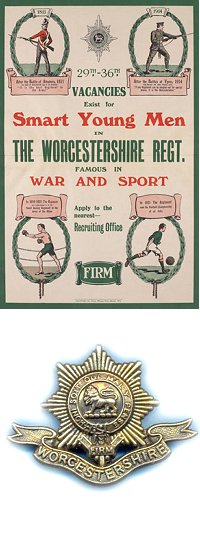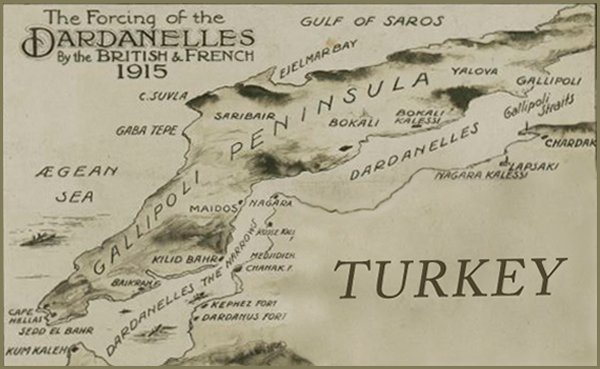yeovil at War
Richard Britton
Killed in Action at Gallipoli
Richard Britton was born in Yeovil in 1884, the son of glover Richard Smith Britton (1860-1931) and Susan Thorne née Harrison (1858-1898). The 1891 census listed Richard and Susan living at 5 Vicarage Street with their children; 7-year old Richard, Walter (b 1886) and Edith (b 1890) and sharing the house with another family of five.
Richard and Susan had another daughter, Bessie, in 1893 and a son, Frank, in 1895. The family then moved to Worcester where, sadly, Susan died in 1898 at the age of 39. In the 1901 census Richard Snr was living at 4 Askew Square, Worcester, with Richard, Bessie and Frank. Richard Snr was working as a skin parer and Richard Jnr, now aged 17, was working as a labourer at a tinplate works.
 Richard
enlisted in the
4th Battalion,
Worcestershire
Regiment at
Worcester. From
his Service
Number 21603
this was most
likely at the
beginning of
1915.
Richard
enlisted in the
4th Battalion,
Worcestershire
Regiment at
Worcester. From
his Service
Number 21603
this was most
likely at the
beginning of
1915.
The 4th Battalion had been stationed in Burma since 1912 and landed in England on 1 February 1915, disembarking at Avonmouth and trained to billets in Banbury as part of their new formation, the 88th Brigade. The 88th Brigade moved to the Warwick area a month later, and the 4th Battalion Worcestershire marched to fresh billets at Leamington on the 5th March 1915.
On 10 March it was ordered that the 29th Division was to be used to support the operations already in progress at the Dardanelles. Once the decision had been made the ensuing movements were swift. On March 12th the 29th Division was reviewed near Dunchurch by His Majesty the King. Next day came secret orders for embarkation, and after a busy week of preparation the troops entrained. The entrainment was a cheerful business. Thousands of the civil population turned out to see the troops off and” a whole army of relations from Birmingham” came down to Leamington to bid the 4th Battalion Worcestershire farewell. In three trains the Worcestershire companies left Leamington, and by breakfast time on 22 March the whole Battalion was reassembled at Avonmouth. There foreign-service helmets were issued and fitted. “It was a lovely morning, bright warm sun, so everyone was as cheerful as could be.” At 11am the troopships came alongside and then for some hours all thoughts were taken up with the business of embarkation. Officially the destination of the force was a secret; and the orders issued at Avonmouth were only to proceed to Gibraltar; but actually the real objective was known and discussed (the ASC had driven down to Avonmouth with their motor lorries labelled, “Cheap trip to the Dardanelles”), and no one was surprised when, on 27 March 1915, the convoy steamed straight through the Straits of Gibraltar and on without a check into the Mediterranean. Malta was reached on the last day of March. After coaling, the transports proceeded on their way in the afternoon on 1 April and arrived at the harbour of Alexandria at daybreak on 4 April, Easter Sunday.
By nightfall of April 8th the whole Battalion was once more on ship, accommodated, together with the 2nd Hampshire, in the big transport “Aragon.” The “Aragon” sailed from Alexandria on 11 April and, after passing safely through the Aegean Islands, reached on 13 April the rendezvous at Lemnos. There was found a great concourse of warships and transports, and there was much of interest to divert the attention of the troops during the ensuing week. By that time all ranks were aware that the enterprise before them was to effect a landing on the Gallipoli Peninsula.
The Gallipoli Campaign, also known as the Dardanelles Campaign, was a campaign that took place on the Gallipoli peninsula in the Ottoman Empire between 25 April 1915 and 9 January 1916. The peninsula forms the northern bank of the Dardanelles, a strait that provides a sea route to what was then the Russian Empire. Intending to secure it, Russia's allies Britain and France launched a naval attack followed by an amphibious landing on the peninsula with the eventual aim of capturing the Ottoman capital of Constantinople (modern-day Istanbul). The naval attack was repelled and, after eight months' fighting, with many casualties on both sides, the land campaign also failed and the invasion force was withdrawn to Egypt. The campaign was one of the greatest Ottoman victories during the war and a major Allied failure.
On 21 April 1915 definite orders were issued for the forthcoming operations. The orders for the 29th Division were to effect a landing on the end of the Peninsula, in the neighbourhood of Cape Helles. The objective of the Division was a line across the Peninsula, including the height of Achi Baba, some five miles from the Cape.
Achi Baba was a prominent hill feature offering a commanding panorama of the Allied beachhead at Cape Helles and was therefore highly placed on the Allied list for seizure. The British initiated repeated attempts upon the hill feature and the local village of Krithia. All had ended in failure to secure the village or the hill with the loss of heavy casualties. On 12 July 1915 a final attempt was made to seize Achi Baba but the attack proved unsuccessful - barely 350 yards gained. As was the norm with operations from Helles casualties were inordinately high. The Allies incurred 4,000 casualties and the Turkish force rather more, 10,000. For all that the Turkish force suffered twice as heavily the encounter nevertheless ended with possession of Achi Baba remaining in Turkish hands. Allied operations henceforth were chiefly sited further north at Anzac Cove and at Suvla Bay.
Richard was killed in action during day-to-day fighting on 6 August 1915. He was aged 31. Richard is commemorated on Panel 104 to 113 of the Helles Memorial, Gallipoli. His name was added to the War Memorial in the Borough in 2018.
gallery

A postcard dated 1915 showing a map of the Dardanelles Campaign.

The Commonwealth War Graves Commission certificate in memory of Richard Britton.